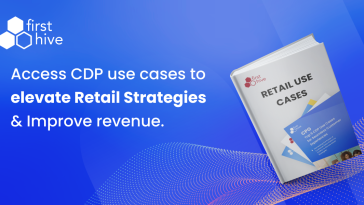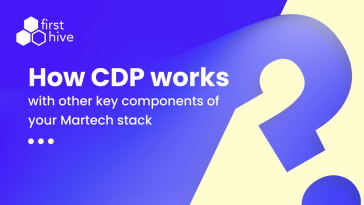As I drove down to work, I spotted a coffee shop. To battle the heavy day, I ordered a hot cappuccino. The guy on the other side asked me for my name and noted it. The swish swipe of my card and my ringtone rang in a chorus. It was my manager on the other side waiting for updates from me. As I settled into a deep conversation with my manager, I almost forgot about my order and started walking out of the coffee shop, until I heard him call out my name. “Bill, cappuccino!”
Rest is not relevant. But, I am sure you would have guessed the name of the coffee shop. It’s Starbucks. They started writing names on the coffee cups. And, that’s how they began personalizing the customer experience.
Personalization has moved beyond just using names. In 2018, research indicated that while 24% of marketers have prioritized targeting and personalization, 31% of surveyed consumers say they wish their shopping experience was far more personalized than it currently is. With both marketers and consumers, equally looking forward to personalization, nothing can get more opportunistic than now to enrich the experience of retail shoppers and increase your returns.

In the retail sector, touchpoints are often offline. E-commerce is no exception to offline touchpoints. Because here, the experience does not end at the checkout page on the website, it ends at the point of delivery, at the assigned address.
To optimize on this opportune trend, many retail brands have already adopted personalization for their customers. Personalization requires to thrive on granular customer data without hurting customer privacy. Here is a full list of potential opportunities that you could tap into to improve your customer’s shopping experience and relationship with your brand with personalization.
Personalization Opportunities For Your Retail Brand
#6 Personalized Coupons & Offers
Retailers are leveraging IoT, deploying sensors and beacons to draw customer data into their systems. These provide data to marketers that can provide real-time personalized coupons and offers on their mobile phones even before the consumer adds a product to the cart. Retailers also use such data and past purchase information to notify the sellers at the PoS and check-out lanes with personalized offers.
IKEA, a Swedish furniture giant uses image recognition technology to provide personalized offers. Using the same technology, customers can also scan catalog items and virtually place them in their own homes to see what they would look like. Food and Beverages industry capitalizes by personalizing offers to those individuals who are loyal to the brand only because of the offer. There are steep discounts to increase loyalty. But, the personalized offers for loyal customers can be a simple compliment or even non-existent without hurting the earning capacity of these loyal customers.
The most enticing opportunity of personalization is to optimize the ROI based on the customer’s purchase behavior rather than generalizing efforts.
#5 Personalized Loyalty Programs
Starbucks has reported revenue soaring to $2.56 billion, with the app contributing around 6 million sales per month. It has personalized a reward system by gamifying its interaction with its customers. It has integrated its rewards system with the ability to customize and order drinks via the app. It uses information such as purchase history and location to get personal.
As a retailer, you can run multiple loyalty programs, but they are futile if you cannot identify how each customer is responding to each of those loyalty programs.
To successfully integrate loyalty programs into your marketing channels, you need a robust filter that authenticates the data flowing into your insights engine. Incorrect data would yield inappropriate insights that can backlash your efforts to engage with your customers. Tools such as Worldswipe help you design loyalty programs for your audience and stakeholders, across the organization.
#4 Personalized Product Recommendations
Product Recommendations keep the cycle of a new sale to an upsale and to a cross-sale stay in continuum.
Retail marketers want to make most out of monthly recurring purchases. Some products are bought effortlessly, while others have to be recommended with relevance. These help in reminding customers consistently about the products that they are likely to buy. Product recommendations help in capitalizing the impulsive purchase behavior of consumers.
Amazon is one such retailer, apparent to everyone when it comes to making most out of personalized product recommendations. Here is a step-by-step process that was used by Amazon. Now it has an improved version of it.

While this may be a basic outline to capture data, personalizing product recommendations largely depends on dynamic data capturing and integrating it with the existing marketing channels and campaigns.
For instance, Amazon uses data coming in from past purchase, products viewed (recommended for you), abandoned carts, shopping wishlists, similar products, complementing products (frequently bought together), substitute recommendations (customers who bought this also bought that), and so on.
Their choice of data collection also includes data from a customer’s cohort and her own behavior. Their recommendation algorithm learns with every new customer action and adapts it into the marketing campaign. A few years back, the company attributed 35% of its sales to product recommendations.
#3 Personalized Preferences
Your customer’s purchase decision influencers can be identified.
Products in retail are largely influenced by the consumers’ local weather, culture, race, nationality, body type, and other such personal characteristics. Some retailers also record data such as average screen time, food timings, sleep time, and other schedules to personalize a customer’s experience. And this is not just about the large retailers. For instance, MyProtein, a sports and nutrition brand personalizes dietary intake pertaining to workouts for each of its customer, articulated as a reminder for consumption.
#2 Personalized Products
Personalizing does not end with marketing campaigns and content.
Product retailers are using customer data to optimize their products and provide the best solution to their customers. Personalizing products empowers product managers to go full-throttle with innovation in product customizations.
Nike, the famous sports accessories brand does this. Nike marketers launched a campaign called ‘sneakerheads’ which allowed customers to customize their sneakers in less than an hour. Nike App at Retail is another initiative. When a customer enters the doors of the Nike retail store, it recognizes the customer and opens up exclusive products in her proximity. Customers can scan for product availability in all nearby Nike doors, or checkout and pay through the app with no waiting line.
#1 Personalized Omni-Channel Experience
Creating consistent experience across multiple channels is what a marketer celebrates.
And, this includes a customer’s in-store experience. The giant retailer Walmart that has a chain of retail stores went on to host its online presence. They are shelling down a few million dollars to achieve hyper-personalization for its customers, online and offline.
For Walmart, this meant personalizing a customer’s experience across multiple store locations, by weather, season, personal preferences, and buying patterns and consumption. It also meant customizing a customer’s purchase path journey across email, website, ad-retargeting, mobile, in-store, and any other possible form of interaction. In the same context, Amazon uses data from Wholefoods to personalize food grocery purchases.

“You know me so well!”
To make every customer says “You know me so well”, dive deeper into personalizing it for ‘segments of one’. To make it happen you need a strong hold on ingesting data from multiple marketing sources, segmenting them into cohorts with intuitive details, applying those insights to your marketing campaigns, and measuring them across the scattered buyer journey and their undulated behavior. A layer of Artificial Intelligence applied to your customer data platform can automate the entire process of omnichannel personalization, and enrich your customer’s experience.
However, no amount of large data can be used without keeping the customer’s trust and data privacy intact. Your customers have the right to anytime withdraw the permission they have given to use their data. To avoid misuse of such valuable data, you would need an equally intelligent platform that can encourage privacy by design.
Talk to an expert 1:1. Schedule a call with us. Sign up here








